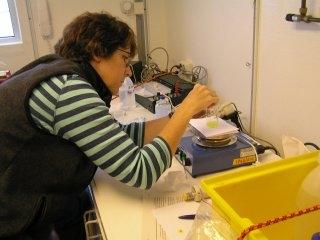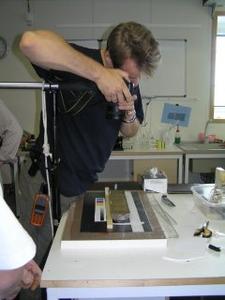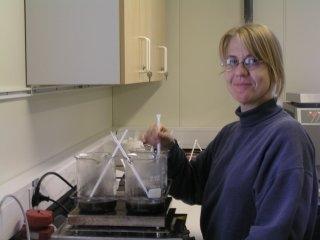4 September, 2004
Around the Labs on the Oden
The drilling winds down - but as it does, work still goes on in the labs.
Core catchers continue to come into the main lab, other samples are sent to
the geochemistry lab.
When the sealed core catchers arrive in the Main Lab on Deck 1, the packages
are opened and the small plastic tubes are arranged in order of core number
on the lab table. They are photographed one by one by Martin Jakobsson.
Alexey Krylov then examines and records the sediment type, consistency and
color. Often this involves squeezing the sediment between his fingers but
more often than not a quick "taste test" better helps him determine the
sediment type. Some of the sediment is scooped away in small constant volume
samples and processed to determine the density with a pycnometer.
Once Martin and Alexey are finished with the core samples the other
scientists are free to take samples of their own for their parcticular
analysis. One of my cabin-mates, Asa Wallin, helps to prepare the sediments
for some of the micropaleontologists soon after they arrive in the lab. She
"cooks" the sediments in seawater and a detergent to help disintegrate them.
Many of the sediments are hardened and need to be broken down into much
smaller parcticle sizes before the scientists can examine them for
microfossils. The beakers of sediments in solution are put on a hot plate
for anywhere from 20 minutes to several hours. A small magnetic rod is
placed in the beaker bottom and magnets on the bottom of the hot plate cause
these rods to spin so the mixture can be automatically stirred as it heats.
Once the sediments are dissolved sufficiently they are sieved to retain
mineral grains from 20 - 500 microns in size. They are then ready to be made
into slides and examined for microfossils.
Asa is also responsible for running the coulometer, a piece of equipment
that measures the amount of carbonate in a sediment sample.
My other cabin-mate, Luzie Schnieders, works the geochemisty lab. On the
Vidar, scientists David Smith and Jerry Dickens collect the microbiology and
geochemistry samples from the newly cored sediments. Sediments are tested
for salinity and alkalinity on the Vidar Viking. Then samples of pore water
and microbiology samples (sediments specially prepared in oxygen-free
packages) come over from the Vidar after each work shift change. Luzie is
responsible first for storing the microbiology and pore water samples
correctly at either -800C or +40C until they can be transported to Bremen,
Germany for later analysis. Some pore water samples must be analyzed for the
presence of ammonia and chloride in the geochemistry lab within 24 hours of
collection. I have spent time with Luzie working in this lab and trying out
the equipment. Another test procedure that was supposed to be done but did
not run parcticularly well on Oden was the GC (gas chromatography). This
process measures the amount of gases, parcticularly methane, in the
sediments. There is a device called the "sniffer" aboard the Vidar to
immediately detect gases such as methane, hydrocarbon and hydrogen sulfide
in the newly cored sediments; some gases trapped in the sediments could
produce a highly explosive situation. The procedure on Oden is a follow-up
test for these gases.
Having spent time with these scientists, watching and assisting I feel much
better prepared to share the experience of lab work with my students. But
now a break from the lab to go out and take more pictures.

Testing pore water for the presence of chloride in the geochemistry lab.

Martin Jakobsson photographing the newly arrived sediments.

Asa working in the main lab.
Contact the TEA in the field at
.
If you cannot connect through your browser, copy the
TEA's e-mail address in the "To:" line of
your favorite e-mail package.
|
